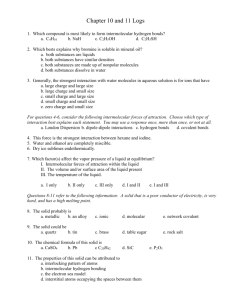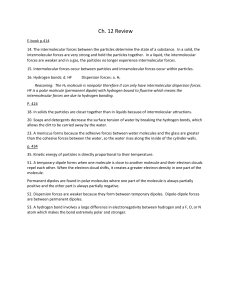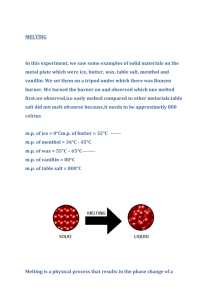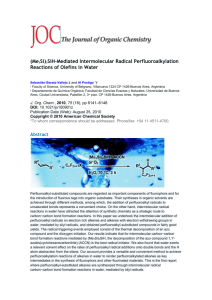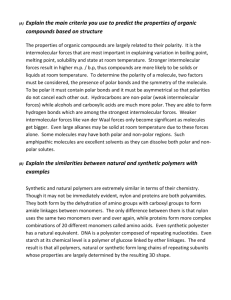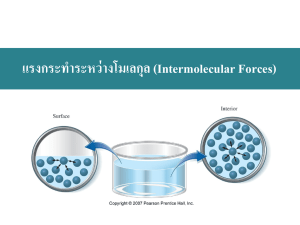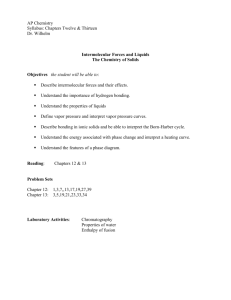Grade 11 Intermolecular Forces Practical
advertisement
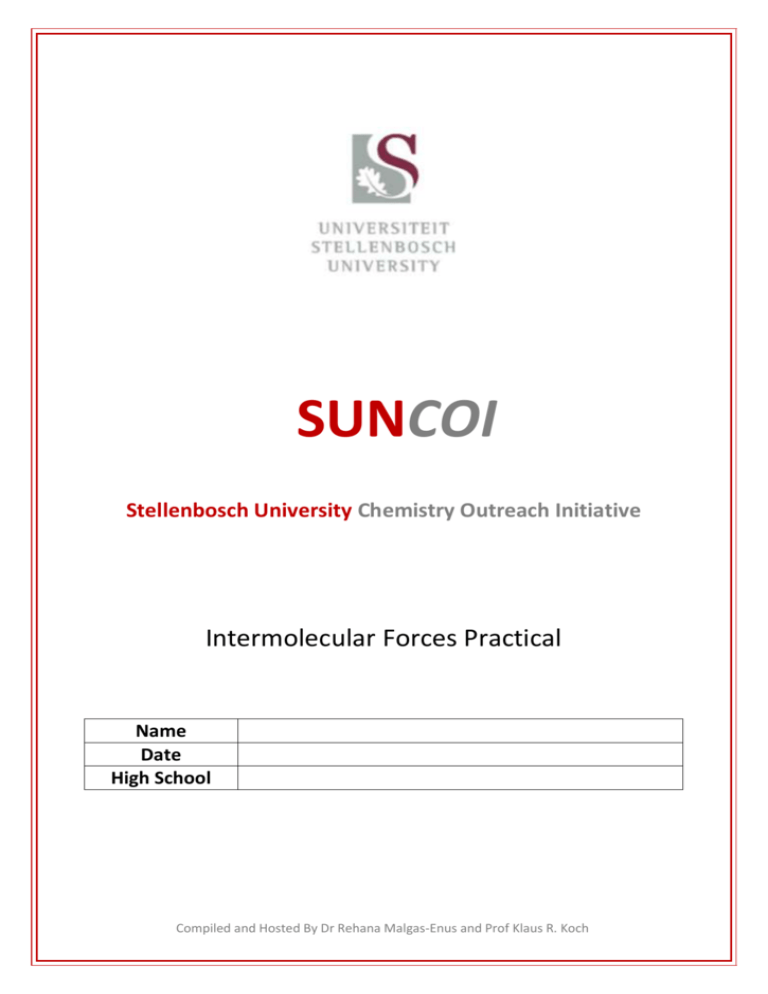
SUNCOI Stellenbosch University Chemistry Outreach Initiative Intermolecular Forces Practical Name Date High School Compiled and Hosted By Dr Rehana Malgas-Enus and Prof Klaus R. Koch Formal experiment 1: To investigate evaporation and to determine the relation between evaporation and intermolecular forces. Formal experiment 2: To investigate surface tension and to determine the relation between surface tension and intermolecular forces. Formal experiment 3: To investigate solubility and to determine the relation between solubility and intermolecular forces. Formal experiment 4: To investigate boiling point and to determine the relation between boiling point and intermolecular forces. Formal experiment 5: To investigate capillarity and to determine the relation between capillarity and intermolecular forces. Compiled and Hosted By Dr Rehana Malgas-Enus and Prof Klaus R. Koch LAB SAFETY In the laboratory, students should behave in accordance with the following general rules that are also displayed on the walls in the laboratories: The practical classes begin promptly at the prescribed times. No student is allowed in the laboratory before or after these times. Take note of the “prohibited” signs in the laboratory. Components that had been distributed must be handed in at the end of the practical. Connecting wire must also be returned. All electrical instruments must be switched off at the end of the practical. Chairs must be returned to their places after use. Tidy bench after use. Defective equipment must be entered in designated fault book in the laboratory. Pregnant students have to get special permission to enter any laboratory. Students, who do not heed the above rules, could be prohibited from using the laboratory again. Compiled and Hosted By Dr Rehana Malgas-Enus and Prof Klaus R. Koch Please do not carry apparatus from one table to the other without permission of the demonstrator. No electrical circuit is to be switched on before it is checked by a demonstrator. Switch everything off after you have finished using it. Please be careful with gas and Bunsen burners. Make sure they are switched off after usage. Please leave the apparatus in neat order after completion of your experiment. Switch off all electrical equipment and disconnect the leads. Report any problems with apparatus (apparatus out of order, etc) without delay to a demonstrator. Handle all apparatus with respect. Please do not smoke in the laboratory and keep noise levels down. Compiled and Hosted By Dr Rehana Malgas-Enus and Prof Klaus R. Koch We would like to thank Mr Malcolm Taylor and Mr Johnny Smit for assisting with the planning and set-up of lab experiments. We would like to acknowledge the following demonstrators who volunteered to help with this practical experiment: Leon Engelbrecht Corli Joubert Hennie Kotzé Jacquin October James Odendal Andrew Swarts We would like to thank the Department of Community Interaction for the transport they provided for the school students. We would like to thank the teachers involved for going the extra mile to ensure that their students have an optimal learning experience: Mr A. Jacobs – Kylemore High School Mrs P. Jonathan – Cloetesville High School Mrs. D. Apples – Luckhoff High School These experiments were adapted from the Grade 11 Physical Sciences CAPS Edition 1 Handbook By SIYAVULA and Volunteers Compiled and Hosted By Dr Rehana Malgas-Enus and Prof Klaus R. Koch The effects of intermolecular forces The following five experiments investigate the effect of various physical properties (evaporation, surface tension, solubility, boiling point and capillarity) of substances and determine how these properties relate to intermolecular forces. Each experiment will look at a different property. Formal experiment 1: The effects of intermolecular forces: Part 1 Aim To investigate evaporation and to determine the relation between evaporation and intermolecular forces. Apparatus You will need the following items for this experiment: ethanol, water, nail polish remover (acetone), isopropanol evaporating dishes (or shallow basins) or measuring cylinders Method 1. Place 10 ml of each substance given in separate evaporating dishes. 2. Carefully move each dish to a warm (sunny) spot. 3. Mark the level of liquid in each dish using a permanent marker. Make several marks at different positions around the dish. If the permanent marker is leaving a smudge rather than a noticeable mark, carefully wipe the side of the dish and try again. 4. Observe each dish every 10 minutes and note which liquid evaporates fastest. Results Record your results in the table below. You do not need to measure the level of the liquid, but rather just write how much the level had dropped (e.g. for water you might write did not notice any decrease in the level or for ethanol you might write almost all the liquid had evaporated). Substance Liquid level after 10 min 20 min 30 min Ethanol Water Nail polish remover Isopropanol Compiled and Hosted By Dr Rehana Malgas-Enus and Prof Klaus R. Koch 60 min Bespreking en gevolgtrekkings Discussion and conclusion Which solvent takes the longest to evaporate? ______________________________________ Which solvent evaporates the fastest? ____________________________________________ Explain why in terms of intermolecular forces: ___________________________________________________________________________ ___________________________________________________________________________ ___________________________________________________________________________ ___________________________________________________________________________ ___________________________________________________________________________ ___________________________________________________________________________ ___________________________________________________________________________ ___________________________________________________________________________ Circle the correct answer: Substances with weaker intermolecular forces evaporate faster/slower than substances with stronger intermolecular forces. (5) Formal experiment 2: The effects of intermolecular forces: Part 2 Aim To investigate surface tension and to determine the relation between surface tension and intermolecular forces. Apparatus You will need the following items for this experiment: water, cooking oil (sunflower oil), nail polish remover (acetone), isopropanol small glass beakers or glass measuring cylinders small piece of glass or clear plastic paper clips Method 1. Place about 10 ml of each substance given in separate small beakers or measuring cylinders. 2. Observe the shape of the meniscus. (This is the level of the liquid). Note what happens at the edges where the liquid touches the glass. (You can place a few drops of food colouring in each substance to help you see the meniscus.) 3. Now place a drop of the substance on a small piece of glass. Observe the shape of the drop. 4. Now try to float a paperclip on each of the solvents. Observe what happens in each cases. Compiled and Hosted By Dr Rehana Malgas-Enus and Prof Klaus R. Koch Results Record your results in the table below. You just need to give a qualitative result (in other words what you see in the experiment). Substance Water Oil Nailpolish remover Isopropanol Shape of meniscus Shape of droplet Paper clip test Discussion and conclusion Which of these substances have the same meniscus shape? ___________________________ Why? ___________________________________________________________________________ ___________________________________________________________________________ ___________________________________________________________________________ Why does the water and oil form a droplet, and the nail polish remover and isopropanol does not? ___________________________________________________________________________ ___________________________________________________________________________ ___________________________________________________________________________ ___________________________________________________________________________ ___________________________________________________________________________ ___________________________________________________________________________ Choose the correct answer: Substances with strong intermolecular forces will generally have a greater/weaker surface tension than substances with weaker intermolecular forces. (5) Formal experiment 3: The effects of intermolecular forces: Part 3 Aim To investigate solubility and to determine the relation between solubility and intermolecular forces. Apparatus You will need the following items for this experiment: Solids: sodium chloride (table salt), iodine, potassium permanganate Solvents: water, ethanol, chloroform 9 beakers or test-tubes or vials 3 A4 sheets of paper Compiled and Hosted By Dr Rehana Malgas-Enus and Prof Klaus R. Koch Method 1. Place about 10 ml of each solvent given in separate beakers. Place this set on a piece of paper labelled “sodium chloride”. 2. Repeat this step twice. The second set is for potassium permanganate (so your piece of paper will say “potassium permanganate”) and the third set is for iodine (so your piece of paper will say “iodine”). You should now have nine beakers in total. 3. Into the first set, add about 1 g of sodium chloride. 4. Into the second set, add about 1 g of potassium permanganate. 5. Into the third set, add about 1 g of iodine. 6. Observe how much of each substance dissolves in the solvent. Results Record your results in the table below. If you observe only a small amount of the solid dissolving then write that very little solid dissolved. If all the solid dissolves then write that all the solid dissolved. Substance Water Chloroform Ethanol Sodium chloride Potassium permanganate Iodine Discussion and conclusion Which substances dissolved in the solvents? ___________________________________________________________________________ ___________________________________________________________________________ ___________________________________________________________________________ Compiled and Hosted By Dr Rehana Malgas-Enus and Prof Klaus R. Koch Which of the substances did not dissolve? ___________________________________________________________________________ ___________________________________________________________________________ ___________________________________________________________________________ ___________________________________________________________________________ ___________________________________________________________________________ Explain why in terms of polarity and intermolecular forces. ___________________________________________________________________________ ___________________________________________________________________________ ___________________________________________________________________________ ___________________________________________________________________________ ___________________________________________________________________________ ___________________________________________________________________________ ___________________________________________________________________________ ___________________________________________________________________________ ___________________________________________________________________________ ___________________________________________________________________________ ___________________________________________________________________________ ___________________________________________________________________________ (5) Formal experiment 4: The effects of intermolecular forces: Part 4 Aim To investigate boiling point and to determine the relation between boiling point and intermolecular forces. Apparatus You will need the following items for this experiment: water, cooking oil (sunflower oil), nail polish remover, isopropanol test-tubes and a beaker hot plate Method Warning: Nail polish remover is highly flammable. It will easily catch fire if left near an open flame. For this reason it must be heated in a water/oil bath. This experiment MUST be performed in a well ventilated room. 1. Place about 10 ml of each substance given in separate test-tubes. 2. Half-fill the beaker with water and place on the hot plate. Compiled and Hosted By Dr Rehana Malgas-Enus and Prof Klaus R. Koch 3. Place the test-tubes in the beaker. 4. Observe how long each substance takes to boil. As soon as a substance boils, remove it from the water bath. Results Write down the order in which the substances boiled, starting with the substance that boiled first and ending with the substance that boiled last. Order of boiling point 1 2 3 4 Substance Discussion and conclusion Which two substances boil first? ___________________________________________________________________________ ___________________________________________________________________________ ___________________________________________________________________________ Explain why these substances boil before the others: ___________________________________________________________________________ ___________________________________________________________________________ ___________________________________________________________________________ ___________________________________________________________________________ ___________________________________________________________________________ Which substance between water and oil, would boil first? ___________________________________________________________________________ Explain why in terms of intermolecular forces: ___________________________________________________________________________ ___________________________________________________________________________ ___________________________________________________________________________ ___________________________________________________________________________ ___________________________________________________________________________ ___________________________________________________________________________ ___________________________________________________________________________ ___________________________________________________________________________ Compiled and Hosted By Dr Rehana Malgas-Enus and Prof Klaus R. Koch Circle the correct answer: Substances with strong intermolecular forces will have a higher/lower boiling point than substances with weaker intermolecular forces. (5) Formal experiment 5: The effects of intermolecular forces: Part 5 Aim To investigate capillarity (how far up a tube a liquid rises or how far down a liquid falls) and to determine the relation between capillarity and intermolecular forces. Apparatus You will need the following items for this experiment: water, cooking oil (sunflower oil), nail polish remover, isopropanol large shallow dish, narrow glass tube Method 1. 2. 3. 4. Place about 20 ml of water in the shallow dish. Hold the narrow tube just above the level of the water in the dish. Observe how far up the tube the water travels. Repeat for the other three substances, remembering to wash and dry the dish and tube well between each one. Results Record your results in the table below. You do not need to measure how far up the tube the substance travels but rather say if it only travelled a short distance or a long distance. Substance Distance travelled up tube Water Oil Nail polish remover Isopropanol Compiled and Hosted By Dr Rehana Malgas-Enus and Prof Klaus R. Koch Discussion and conclusion Which substance travels the furthest? ____________________________________________ Which substance travels the least distance? ________________________________________ Complete the sentence: These results are observed because capillarity is related to ____________________________ Circle the correct answers: Substances with strong/weak intermolecular forces will travel further up a narrow tube (have a greater capillarity) than substances with stronger/weaker intermolecular forces. (5) Overall Conclusion Write a summary of the effects of intermolecular forces on surface tension, solubility, evaporation, boiling point and capillarity. ___________________________________________________________________________ ___________________________________________________________________________ ___________________________________________________________________________ ___________________________________________________________________________ ___________________________________________________________________________ ___________________________________________________________________________ ___________________________________________________________________________ ___________________________________________________________________________ ___________________________________________________________________________ ___________________________________________________________________________ ___________________________________________________________________________ ___________________________________________________________________________ ___________________________________________________________________________ ___________________________________________________________________________ ___________________________________________________________________________ ___________________________________________________________________________ ___________________________________________________________________________ ___________________________________________________________________________ ___________________________________________________________________________ ___________________________________________________________________________ ___________________________________________________________________________ ___________________________________________________________________________ ___________________________________________________________________________ ___________________________________________________________________________ ___________________________________________________________________________ ___________________________________________________________________________ ___________________________________________________________________________ ___________________________________________________________________________ ___________________________________________________________________________ Compiled and Hosted By Dr Rehana Malgas-Enus and Prof Klaus R. Koch ___________________________________________________________________________ ___________________________________________________________________________ ___________________________________________________________________________ ___________________________________________________________________________ ___________________________________________________________________________ ___________________________________________________________________________ ___________________________________________________________________________ ___________________________________________________________________________ ___________________________________________________________________________ ___________________________________________________________________________ ___________________________________________________________________________ ___________________________________________________________________________ ___________________________________________________________________________ ___________________________________________________________________________ ___________________________________________________________________________ (5) Compiled and Hosted By Dr Rehana Malgas-Enus and Prof Klaus R. Koch
